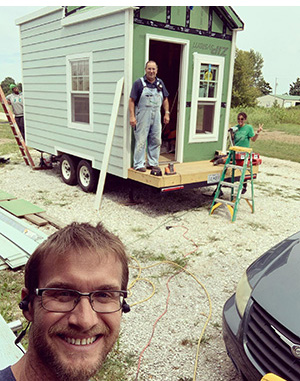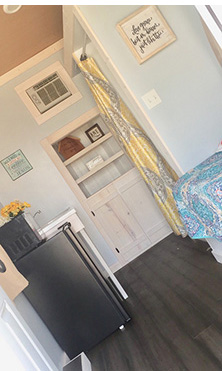By TR Robertson
Curtis and Hany White have a big vision to help the homeless . . . by building tiny houses.
One day, Curtis White saw a man struggling to peddle a bicycle uphill and against the wind. The bicyclist was pulling a trailer. The man went to a dumpster next to a mattress store and grabbed several mattress-sized sheets of cardboard.
“It was clear he was getting them for a makeshift shelter, which, of course, isn’t going to last long at all,” Curtis White said. “I was thinking how easy it would be for me, with 20 years of carpentry experience, with even just a few sheets of plywood, to build something that would work better.
“Then I saw a tiny house documentary on Netflix. That’s when I realized maybe I could build homes for people like that man. [A tiny house] provides all your basics. It just made sense.”
THE BIG IDEA
The Whites—a family of four—began by building a 425-square-foot tiny house for themselves. That undertaking provided them a chance to put their research and skills to work, learning the ins and outs of such a project. Their tiny house is only about one-fourth the size of an average house, but it was built using the same construction methods and materials.
The “big idea” of Tiny House Ministries (THM), however, is to build micro-tiny houses with a footprint of 100 to 300 square feet, each with a sleeping area, toilet, shower, sink, microwave, and refrigerator.
The first micro-tiny home they built was used to promote the ministry at the International Conference on Missions in the fall of 2019. The “show house” at ICOM drew a crowd, including Tom Hawks, an elder at New Community Christian Church in Salina, Kansas.
“I love the concept of building one house at a time to serve one person at a time,” Hawks said. “I share that passion with THM, so I put together a small mission team to serve someone that we may never meet.”
In the year and a half since that particular ICOM, Hawks and his Bent Nail Ministry teams have traveled to the Whites’ home in Anabel, Mo., several times to join volunteers from local churches and other ministries to construct tiny buildings.
“Tom Hawks has been a good partner in ministry,” White said. “He has mentored me on how to structure group builds, so I could go from projects where I’m doing most of the work on my own, to coaching others in the tiny house building process.
“We find locations that need houses, and I design the houses based on the needs of the ministry we’re trying to serve,” White said. “We connect the dots with people who are ready to volunteer in building projects. When they arrive, we try to have the supplies on the ground and the plans and cut list ready to go.
“Each build is unique to the need and costs vary, but [they] average $7,000 to $8,000,” he said. “Depending on the particulars of the location and situation, there could be additional set-up costs. But for under $10,000, anyone can start a new ministry.”
TINY HOME
Clarence (Mo.) Christian Church partnered with THM to host that first micro-tiny house on their church property.
“In most communities, tiny houses will be classified as a recreational vehicle, and RVs are legal everywhere, just not always for full-time living,” White said. “You could put a homeless person in an RV and park it in the church parking lot. In Missouri, I think you can do that for up to 30 days.
“But for churches and other ministry organizations, there tends to be more leeway. Religious organizations tend to be allowed to use their property for ministry purposes in ways that the individual person cannot.”
Their first resident had been homeless for six years and was living on the streets of nearby Columbia in the winter months of late 2019. Through Hany White’s connections with a Columbia nonprofit, the young woman was able move into the house from January through March 2020.
“I was worried it might be too cold in the winter, but our first resident said she was fine, that she actually got hot sometimes,” Curtis White said. “If it’s built poorly or if it doesn’t have a heater and air conditioner that’s up to the task, then you’re going to have issues. A local company donated spray foam insulation for the first house. With the small size and the spray foam, it doesn’t take much to heat with a 1,000-watt baseboard heater.”
In July 2020, they placed another young woman in that micro-tiny. She had been a foster child and was in college when the pandemic forced her to leave the dorm and she found herself homeless. The first week she was in that tiny house, she got a job. That fall she enrolled at Central Christian College of the Bible in Moberly, Mo.; she commuted there before moving out of the Clarence house in October 2020.
The Whites and a group of volunteers from the Clarence church took turns meeting the needs of those residents. Hany White, who has a master’s degree in counseling, facilitated what they call the Tiny Path Plan, a logical set of sequential steps for scheduled counseling, weekly church attendance, and more.
“I want to see those people who have been a part of these small-town churches for years to get to know homeless people and be able to help them,” Curtis White said. “It’s been really sweet to see the interaction between the church members and the new residents, bringing meals and meeting basic needs.”
That first tiny house is now being moved to a new church plant in West Virginia, where a family THM previously helped build their own tiny house has moved and is currently serving.
In June 2020, THM and volunteers built another micro-tiny house to be used as a presentation house. Eventually it will also be placed with another church or ministry.
EXPANDING OPPORTUNITIES
Through Facebook, White discovered that an Independence, Mo., homeless outreach ministry called Hands and Feet of Jesus wanted to build or buy a mobile shower unit.
“I knew I could provide something that would be more affordable than what they were looking at, so I contacted them.”
THM designed the unit and, during a three-day period in November 2020, built the shell with local helpers and volunteers from Salina and Independence. The unit was then sent to Independence, where volunteers finished the interior.
The “Clean Start” shower trailer has three doors that lead into secure shower units with a changing area and mirror. A fourth door leads to a utility and storage room.
A LARGER PROJECT
Grace Living Center in Clarksburg, Mo., a long-term transitional living center for homeless women with addictions, has long-term plans to construct six to eight tiny houses. In March 2021, 14 volunteers gathered to build the first two 220-square-foot houses simultaneously. The tiny homes satisfy the requirements of the state Division of Family Services.
“One of the needs is to house women who are working through a program to earn the right to resume custody of their children,” White said. “DFS tells them it’s up to them to get a job and to find suitable housing for their children. The tiny houses provide a place behind the main building, so they can still be closely connected with the services of GLC.”
Each unit includes a bathroom with a shower and toilet, with a door that closes and locks, so mothers and children have a private place to change. A 75-square foot loft area has room for two separate beds. The downstairs has about 100 square feet of open area aside from the kitchen and bath area. There’s room for an optional sleeper sofa there. The kitchen has a microwave, about five feet of countertop, a sink, shelving for appliances, and a dorm-size refrigerator. (It’s possible to adapt the living space for a larger refrigerator.)
Additional tiny construction projects are in the planning stages, including a trip to Salina for White to supervise construction projects there.
What began as a simple idea to build housing for homeless people has expanded in unexpected directions, but the Whites’ dream remains simple.
“We’re here for anyone who is interested in building a tiny house to do some sort of ministry,” Curtis White said. “If churches or organizations want to reach out to us, we’re willing to consult with them.”
TR Robertson is a Christian writer who lives in Columbia, Mo.




Here is another – started as a ministry of Landmark Christian Church in Chippewa Falls, WI. Is currently in it’s 6th year and has 9 houses.
https://www.hopevillagechippewafalls.org/
https://www.facebook.com/groups/1514659905531039
Most Americans are not homeless for the reasons one would like to believe. Demon possession is the root cause, and until the demon is cast out of such individuals, it is pointless to cast your pearls before them. Come to Asia and I will show you the truly poor and destitute.
Hello my name is Kerri and I’ve been going through homelessness for the past ten years. I’d like to start a tiny house ministry here to help brake the homeless cycle I’ve been going through. Do you have any information on starting this kind of ministry? I’d really appreciate it, thank you. God bless
May God bless you all